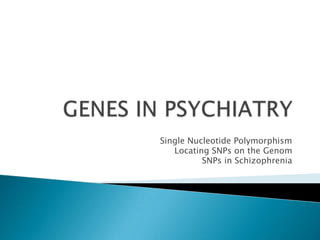
Genes In Psychiatry
- 1. Single Nucleotide Polymorphism Locating SNPs on the Genom SNPs in Schizophrenia
- 2. The human genome sequence is 99.6% identical in all people. However there are certain positions on the DNA where some people have one nucleotide pair, while others have another. These positions are known as SNPs. SNPs make up 0.4% of the genome(12 million base pairs). Differences at these places make us unique. A SNP can be thought of as an address of a house on a street. A SNP can have various “occupants”(the four nucleotides A,T,C,G).
- 3. SNPs occur every 500-1000 nucleotides (base pairs). They can be thought of as markers.
- 4. Synonymous: SNP in the coding region (exons) that do not influence the structure of the protein. Conservative: Alter the structure of the protein, but not its function Functional: Alter the function of the protein. SNPs can occur in any part of the DNA, such as in exons(coding regions of DNA) introns (non-coding regions of DNA) regulatory regions of DNA
- 6. DNA of a group of patients is scanned for specific SNPs and compared to a control group. If a SNP is more frequent in the patients compared to the control group it may be a marker or candidate SNP.
- 7. Very efficient methods have been developed for comparing SNP alleles. This chip can test over a million SNPs for a person in one step. The chip is simply soaked in saliva or blood, then placed in a machine that collects the data and sends it to a computer. Example of RESULT:
- 8. The range of human traits that can be studied with SNPs is very broad- from simple physical traits like curly hair to complex medical conditions such as breast cancer, schizophrenia or diabetes.
- 9. Genomics reveal relative risk of a disease in terms of probability. It cannot predict who will or will not get sick (red bars represents probabilities)
- 10. Candidate genes for a condition can be identified by: Linkage strategy( for diseases that run in families) Association studies(such as genome wide association strategy) in which the whole genome is scanned for SNP.
- 11. Blue lines indicate areas for which suggestive evidence of linkage has been found in more than one data set. Red lines indicate regions where evidence of linkage has achieved genome-wide significance. Red arrows indicate the site of chromosomal abnormalities associated with schizophrenia. Yellow circles indicate the location of genes implicated as possible schizophrenia susceptibility loci.
- 12. Many susceptibility genes with high probability for schizophrenia are involved in brain wiring, myelination, neuronal migration, neurogenesis, etc. The gene coding for the enzyme catecol-o- methyl transferase (COMPT) is the only identified gene directly related to dopamine.
- 14. Neuregulin gene tested positive in several psychiatric conditions including schizophrenia, bipolar disorder and Alzheimer’s disease. Neuregulin is involved in myelination, synapse formation, oligodendroglia development and axon guidance.
- 15. Multiple studies including STAR-D identified SERT as being a susceptibility gene for depression.
- 16. DRD2 = carriers of the Del allele may demonstrate less satisfactory antipsychotic drug response compared to Ins/Ins allele. COMPT= Patients with the homozygous Val/Val allele may be less likely to respond to SSRI treatments . COMPT 158 Val/Val genotype=dopamine is degraded at a higher rate increasing chances for cognitive defects. CACNA1C=The A allele has been associated with elevated rates of mood disorders. SLC6A4=Carriers of (S) or L(G) alleles may be less likely to respond to SSRIs and more likely to experience side effects.
- 17. Genes operate at a very basic cellular level. Genes do not code for mental illness or for symptoms of mental illness. Genes do not respect the boundaries of schizophrenia, schizoaffective, bipolar disorder or Alzheimer’s disease. Genes do not seem to validate the DSM. For instance neuregulin (positive in 15 studies world wide) is present in schizophrenia, bipolar disorder and Alzheimer’s disease.
- 19. Genes don’t seem to respect the boundaries of psychiatry, neurology or medicine. At the molecular level many diseases such as Diabetes type 2, stroke, hypertension, asthma, many cancers, amyotrophic lateral sclerosis, Alzheimer’s disease, schizophrenia etc. are like tributaries that converge into the river of multifactorial (chronic) disorders.
